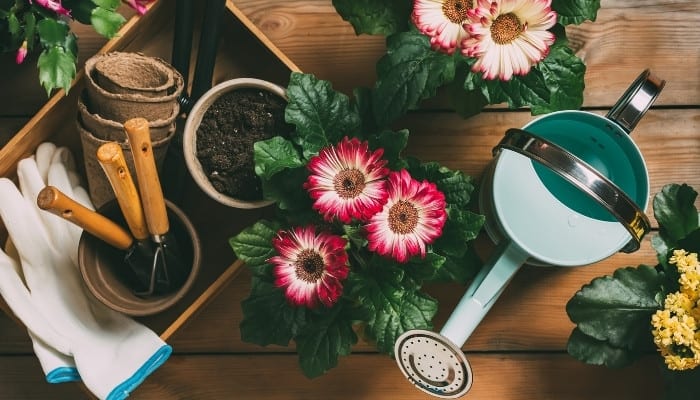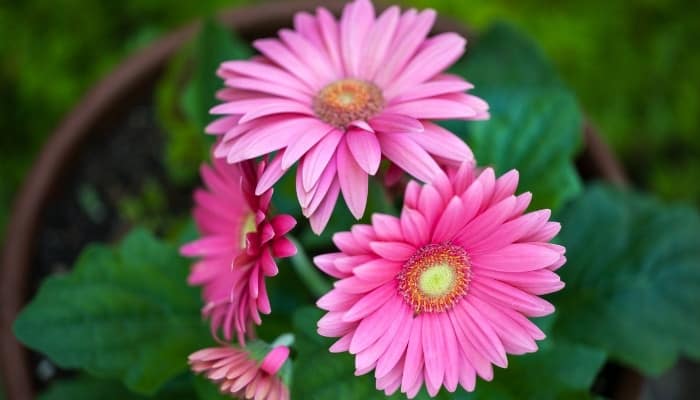Gerbera daisies, which belong to the Asteraceae (daisy) family, are known for their unique and eye-catching appearance.
The species have a big capitulum that may be orange, yellow, red, white, red, pink, or other colors.
Like other flowers with capitulum, like dandelions and sunflowers, the gerbera daisies’ “flower” is actually made up of hundreds of little flowers.
If you love these flowers as much as we do, you’ll want to learn these 13 simple tips to keep your gerbera daisies blooming as long as possible!
1. Remove Spent Blooms
The first step to keep gerbera daisies blooming is simply removing spent blooms.
As the flowers begin to fade, deadheading them (removing them by cutting them off) is the best practice.
Deadheading your gerbera daisies forces them to begin developing new flowers rather than continuing to supply wasted energy to dead or dying flowers.
Removing spent blooms is the most straightforward way to make these exotic daisies push out more beautiful blooms more often.
2. Fertilize Routinely
Gerbera daisies, or gerber daisies, require fertilizing routinely, every two weeks or so. For the best results, liquid fertilizer for blooming plants is recommended.
I recommend this fertilizer packed with micronutrients to encourage continued flower production.
Keep in mind that during the summer time the flowering phase slows down, and fertilizing may need to slow down as well.
After the heat for the year is over, pick up fertilizing every two weeks again.
Keeping these daisies routinely fertilized is a sure path to bigger and better blooms. It also means more frequent blooming in general.
3. Water Thoroughly Only When Soil Is Dry
As with many flowering plants, gerbera daisies prefer watering only when the soil has completely dried out.
That said, in general, these gorgeous flowers require around an inch of water per week.
Depending on the heat, and local environment in general, your watering schedule may be anywhere from once every 3 to 5 days to once every 7 to 10 days.
Watering these flowers properly encourages more frequent blooming.
4. Avoid Wetting Foliage
Gerbera daisies don’t enjoy foliar sprays (learn what these are here) or misting. In fact, doing so may cause damage to their leaves and flowers.
Avoid wetting foliage by watering the base of the plant, targeting the root zone only.
When these daisies get wet foliage, the blooms that already exist may become droopy and new blooms may occur less frequently than otherwise.
5. Provide Adequate Light
Gerbera daisies enjoy light all day long but not much bright and direct sunlight. Morning sun or evening sun is best.
These flowers do the best when they receive just a few hours of direct sunlight and are left to relax in the semi-shade for the majority of the day.
When these daisies are in their preferred light setting, their blooms pop up more often and stay perky longer.
Discover how to determine what type of light your daisy is receiving in this article.
6. Make Sure the Soil Is Fresh and Drains Well
Gerbera daisies get the majority of their nutrients from the soil in which they’re growing.
Unlike some plants that may take in nutrients through their leaves via foliar spray and misting, these daisies rely solely on what they can get from the soil.
Make sure that the soil you plant them in is fresh and nutrient dense.
Also, make sure that it drains well. Otherwise, the flowers will have a hard time absorbing enough food from the soil.
Too much water and old soil that lacks nutrients equals less blooms.

7. Avoid Excessive Heat
Excessive heat causes gerbera daisies to slow their production.
When summertime temperatures kick in, the blooms slow down considerably. That’s because they enjoy weather that is 70°F or less.
Fall is the perfect time for gerbera daisies to bloom due to the cooler temperatures.
Likewise, shadier spots in your yard and garden provide the right type of environment to encourage your flowers to keep blooming longer.
8. Snip Off Fresh Flowers To Encourage More Blooms
As mentioned above, deadheading your gerbera daisies’ faded blooms keeps them blooming at higher rates. That said, snipping off fresh flowers also encourages more blooms as well.
This type of pruning is particularly helpful when your flowers aren’t blooming as much as you’d like.
Sacrificing the few blooms that have shown up is a sure way to force a higher number of blooms to develop.
Don’t feel like you’re wasting pretty flowers. Bring the cut blooms inside and place them in a pretty vase to be enjoyed.
9. Thin Leaves To Increase Light at the Crown
Another method to keep gerbera daisies blooming is thinning out the leaves, specifically toward the center and top of the plant.
When you thin leaves out on the top half of the plant, you’re helping the crown receive more light.
More light to the crown of the flowers means more blooms!
10. Check Routinely for Pests and Diseases – Treat Promptly
It might not sound like a tip to keep your gerbera daisies blooming, but routinely checking for pests and diseases is indeed an excellent method for prolonging blooming.
This is because when a plant is under attack, its energy is redirected to survival instead of reproduction (blooming).
No pest or diseases to fight means that the plant can feel free to produce multiple blooms.
As soon as you notice pests, disease, or harmful bacteria, you must take steps to treat the plant promptly. Otherwise, your blooms may die off faster and new ones will take longer to appear.
11. Remove Old/Dying Leaves
Albeit, removing old and dying leaves is a pretty standard maintenance step for most plants, it is also a great way to keep gerbera daisies blooming.
That’s because when you remove dead and dying leaves it increases the amount of energy the plant receives from the sun.
Removing old and dying leaves from the plant also helps the plant to redirect its energy to new blooms rather than trying to support old and dying parts of the plant.
12. Repot When Necessary
If your gerbera daisies are potted, consider repotting them regularly.
The reason behind repotting it is dual-purpose: One, it helps prevent the plant from becoming root bound, and secondly, it ensures that your soil is fresh, filled with nutrients, and drains well.
When you repot your daisies, make sure to use new soil and fertilizer. Also, make sure that the drainage holes in the pot aren’t clogged with dirt or debris.
13. Expect Breaks From Flower Production
Gerbera daisies bloom for weeks at a time, normally in the spring, summer, and fall.
However, when the temperatures are less than 40°F or higher than 70°F, expect breaks from blooming.
Likewise, expect a break in flower production from your daisies if you aren’t watering, fertilizing, and pruning often enough.
If the flower isn’t getting the right amount of light, isn’t draining well-enough, or is affected by other environmental factors, blooms may slow down or stop altogether.
Finally, after a vigorous period of bloom production, it’s natural to notice a break as the plants renews itself for another blooming cycle.
A Final Word About Keeping Gerbera Daisies Blooming
If you’re following the above baker’s dozen of tips to keep your gerbera daisies blooming, you’ll be pleasantly surprised at how many flowers your plants produce.
Furthermore, if this is your first time growing gerbera daisies, feel free to refer back to this article and our tips as often as needed!

